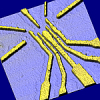Spins in a box
In recent years, TU Delft scientists have made great progress in research on quantum computation and towards a quantum computer. They are able to isolate a single electron in a ‘quantum box’ (quantum dot), and the spin of this confined electron serves as a quantum bit (qubit), the elementary building block of a future, superfast quantum computer. In a simplified picture, the spin corresponds to the direction of rotation of the electron. If an electron rotates one way, it is a spin-up electron; if it rotates the opposite way, it’s called a spin-down electron. These two directions represent the state (‘0’ or ‘1’) of a qubit.
Double
It has been possible for a while to read out the spin of just one electron; TU Delft was the first to show this. The university was also the first to manipulate that one single spin. Now, a team of researchers led by prof. Lieven Vandersypen of the Kavli Institute of Nanoscience of TU Delft, have succeeded for the first time to read out the state of two spins.
The scientists created two quantum dots, with one electron each. Read-out is achieved by allowing each electron to either jump out of the dot or notremain trapped, depending on its spin state. Using a charge detector, the scientists record whether or not the electron jumped out, and can then infer the spin state as well.
Single-shot read-out
The read-out occurs in single-shot mode. In every shot, the state of both spins is recorded. This is crucial in order to probe correlations between the two qubits. First author Katja Nowack: ‘Very fun was that two spins which we placed in a so-called entangled state, always gave opposite outcomes: if one spin was found down, the other was found up, and vice versa, exactly as predicted by quantum theory.’ Entanglement is a unique quantum mechanical phenomenon which is of great importance for quantum information. Two entangled spins cannot be seen separately from each other: their states are intertwined, even if the spins themselves are very far from each other.
Two-qubit gate
Reading out a qubit is important, but one needs to be able to compute with it as well. The Delft scientists have shown for the first time in full that the so-called exchange-gate acting on two spins works well. They pushed the spins together for a short amount of time (about 10 nanoseconds), so that they may interact with each other, allowing their spin states to become partly or completely exchanged.
Future
In the present measurements, a fidelity of 86% was achieved. According to the researchers, a much higher fidelity is possible through technical improvements. The results clearly suggest that it is possible to read out double (or multiple) qubits and, furthermore, that this technique can be used to probe two-qubit gates and correlations. This represents another step along the road to a quantum computer.
Links:

